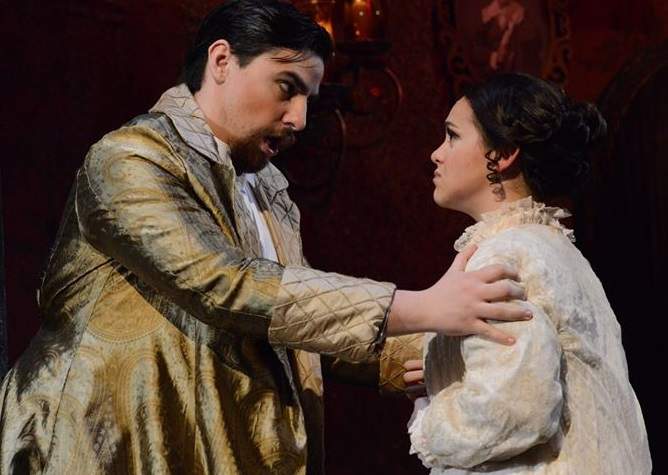
The IU Opera Theater's Lucia di Lammermoor is a musically rich, dramatically taut, lavishly mounted and produced dark spectacle. It's an Italian vision of Sir Walter Scott's Scotland, a dark misty land of clans, family pride and passionate politics.
After the briefest of percussively menacing preludes, the two dozen men of the opera chorus fill the scene. The members of the guards and Ashton Household are loosely spread across the stage in front of a ruined tower. Led by kilt-clad tenor Doowon Kim they're all in search for a mysterious intruder who's been meeting with Lucia Ashton. Most are armed, though a gardener is bearing his rake and a cook is toting a frying pan.
The opening scene neatly introduces the main characters and the plot. Baritone Enrico Ashton is planning to recoup the family's fortunes and his political safety by marrying his sister Lucia to Lord Arturo Bucklaw. Bass Raimondo, the chaplain reminds him that Lucia is still in mourning for her mother. Enrico is nervous that this intruder might derail his plans and when he learns that it's tenor Edgardo the leader of the hated Ravenswood family, he swears vengeance.
With a quick set change, heralded and accompanied by harpist Beste Toperlak, soprano Lucia and her companion alto Alisa arrive for a meeting with Edgardo. Lucia tells her companion that the ghost of a murdered woman appeared to her from the nearby fountain and that as lighting designer Patrick Mero allows, the water ran blood red. Despite this Lucia is very much in love and in a bit of physical anticipation of the visit from Edgardo. Tenor Edgardo arrives, but reports that he's off on a secret mission for Scotland to France. There's a lovely duet and to seal their love, the two exchange rings and vows.
Some weeks later, Enrico has arranged for Lucia to seal the political alliance with the Bucklaws by marrying Arturo and armed with forged letter of Edgardo's infidelity he confronts his sister. In Saturday night's offering it was a spell binding performance with Lucia resisting and Enrico pulling out all the stops. Among other threats, he tells her that if she doesn't marry Arturo, she'll be dreaming of the axe that chops off her brother's head. Chaplain Raimondo adds that the vows she shared with Edgardo are not recognized in the world or in heaven and she relents.
The wedding scene is in a wonderfully detailed hall. Those two dozen, now neatly dressed, men from the opening scene are joined by two dozen beautifully gowned women in a reception and formal greeting for tenor Joseph Ittoop as Lord Arturo Bucklaw. He's a gracious and charming guest with a warm smile for everyone. He signs the marriage contract with grace and Lucia signs with reservations. In the midst of all this formal pomp, a pistol toting Edgardo-reminding me a bit of a young Matt Damon-arrives. Following a moment's tension the famous sextet begins with Edgardo and Enrico in duet, grows as Lucia and Raimondo sing, then with the chorus and Arturo and Alisa joining. The marriage contract with its signatures is displayed and Edgardo, cursing Lucia is thrown out.
As the curtain rises on wedding night, the bride and groom have retired and the chorus is in a wonderfully full bacchanalian mode. Formal dress has been abandoned as the guest frolic in intricately choreographed abandon. It's only interrupted when chaplain Raimondo announces that Arturo the groom has been killed and he fears retribution for all.
Lucia and flutist Trey Bradshaw hold sway as the fascinated guests take in her pitiful and majestic drama in the scene that's become the opera's touchstone. It's a powerfully planned and delivered scene from the maddened soprano's appearance to her collapse. For many this is where Lucia di Lammermoor ends, but there's still more dramatic and moving music for the outward waves of the tragedy.
Edgardo wandering in a wonderfully imagined cemetery sings his laments for Lucia and prays for death. He is interrupted as black clad formal mourners and a giant hearse appear with Lucia's body. Hoping to unite with her in heaven, as they haven't been able to on earth he stabs himself and dies.
In Saturday night's cast Rose-Antoinette Bellion was a compelling Lucia. Yujia Chen was her sympathetic companion Alisa. Ian Murrell as Lucia's brother Enrico was a powerful singer, especially captivating in his scenes with her. Julian Morris did a fine job with the key role of the family's chaplain, a realist in this world, but with concerns about the next. Joseph McBrayer nicely matched Lucia in their love songs and wedding, dueled with Enrico in the sextet and eloquently expressed his broken sadness in the finale.
Saturday night's audience applauded individual scenes and arias, and as at the curtain, as the cast filled the stage rose to its feet to deliver a well-earned standing ovation.
The IU Opera Theater's production of Gaetano Donizetti's Lucia di Lammermoor conducted by Gary Thor Wedow with stage direction by Jose Maria Condemi, and set and costumes by Philip Witcomb continues on March 2nd and 3rd in the Musical Arts Center.
You can find this review and an interview with soprano Kelli Motter and tenor Joseph McBrayer at WFIU.ORG/ARTS
At the theatre for you, I'm George Walker






